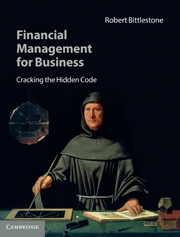Book contents
- Frontmatter
- Contents
- List of figures
- Introduction
- Acknowledgements
- Part 1 A dream of future wealth
- 1 Income and outcome
- 2 Fool's gold
- 3 Play the game
- 4 The judgment of balance
- 5 Return to reality
- 6 The cost of success
- 7 Profit and cash
- 8 Time to take stock
- 9 A capital asset
- 10 Mind your own business
- 11 The taxonomy of fog
- 12 The Merchant of Florence
- Part 2 The hidden art of management
- Appendix 1 Mathematical anchor
- Appendix 2 Getting to grips with cash
- Postscript
- Bibliography
- Index
11 - The taxonomy of fog
from Part 1 - A dream of future wealth
Published online by Cambridge University Press: 05 June 2014
- Frontmatter
- Contents
- List of figures
- Introduction
- Acknowledgements
- Part 1 A dream of future wealth
- 1 Income and outcome
- 2 Fool's gold
- 3 Play the game
- 4 The judgment of balance
- 5 Return to reality
- 6 The cost of success
- 7 Profit and cash
- 8 Time to take stock
- 9 A capital asset
- 10 Mind your own business
- 11 The taxonomy of fog
- 12 The Merchant of Florence
- Part 2 The hidden art of management
- Appendix 1 Mathematical anchor
- Appendix 2 Getting to grips with cash
- Postscript
- Bibliography
- Index
Summary
A practical botanist will distinguish at the first glance the plant of the different quarters of the globe and yet will be at a loss to tell by what marks he detects them.
Carolus LinnaeusIf you have been following this text diligently then you will by now have learnt the rules of double-entry accounting by using a business simulation. Notice also that the diagram presented in Figure 10.1 is structurally almost identical with that of Figure 1.5 – in other words, the connections between boxes and pipes are just about the same. The main difference is that I have rearranged the layout of the boxes and pipes on the page in order to present the Profit and Loss Account from top to bottom in the usual way, rather than reading from right to left. There is also a deliberate simplification regarding tax and dividend payments that is dealt with in a note to the previous chapter.
How does this framework help us to understand the real world and the business meltdowns that seem to take place every few years? In Chapter 2 I suggested that the following equation was the underlying cause of great bankruptcies through the ages:
Estimated Profit = Measured Cash Flow + Assumed Asset Increase
How can we relate this equation to the business simulation we have developed so far? As before, we can achieve this by simplifying the accounting model of Figure 10.1 to throw light on the key movements.
- Type
- Chapter
- Information
- Financial Management for BusinessCracking the Hidden Code, pp. 70 - 78Publisher: Cambridge University PressPrint publication year: 2010



